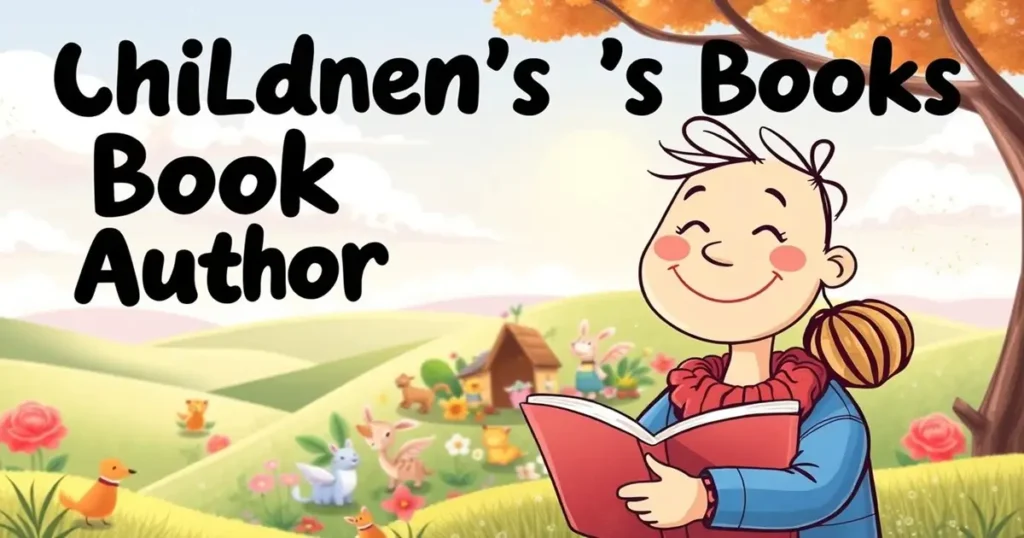Did you know that 70% of children’s book purchases are made by adults, not the kids themselves? Parents, teachers, and librarians are the primary audience for these titles. This presents a unique challenge: authors must connect with adults while creating content that appeals to young readers.
Despite the rise of digital media, print books remain the preferred format for children’s literature, outselling ebooks by a ratio of 3:1. This trend highlights the importance of focusing on traditional formats while still leveraging digital tools for promotion.

Take inspiration from Karen Inglis, who sold over 500,000 copies of her book “The Secret Lake” using a hybrid strategy. Her success underscores the value of combining local community engagement with a multi-channel approach.
Building a strong brand as an author is essential. Social media platforms like Instagram and TikTok can help you reach your audience effectively. Engaging with parents and educators through live Q&A sessions and virtual interactions fosters trust and connection.
Table of Contents
Understanding Your Audience: Kids Aren’t the Buyers
Adults, not kids, are the primary buyers of children’s literature. While young readers enjoy the stories, it’s parents, teachers, and librarians who make the purchasing decisions. This dynamic shapes the way we approach promoting these titles.
Parents account for 68% of children’s book purchases, often building home libraries for their kids. Teachers and librarians also play a significant role, influencing classroom reading lists and library collections. Understanding these decision-makers is crucial for success.
Why Parents, Teachers, and Librarians Hold the Key
Parents are the most frequent buyers, often seeking books that entertain and educate. Teachers, on the other hand, look for titles that align with curriculum goals. Librarians focus on books that appeal to a wide range of young readers, ensuring multiple copies are available.
Karen Inglis’ strategy highlights the importance of these groups. Her local library events generated 30% of initial sales, while flyers in parent-heavy cafes helped spread the word. Engaging these audiences directly can lead to significant results.
Tailoring Your Message to Adult Decision-Makers
When targeting parents, emphasize how the book fosters creativity or learning. For teachers, highlight its educational value and alignment with classroom needs. Librarians appreciate books that are versatile and appeal to diverse age groups.
Adjusting your messaging for each group ensures your work resonates with the right audience. This approach not only boosts sales but also builds long-term relationships with key influencers in the children’s book market.
How to Market a Children’s Book: Foundational Strategies
Your author brand is more than just a logo; it’s the essence of your connection with readers. A well-defined identity helps you stand out in a competitive market. Authors with professional headshots see 35% more engagement, highlighting the importance of visual appeal.

Building an Author Brand That Resonates
Start by outlining essential elements like visual identity, core values, and a unique voice. Karen Inglis, author of “The Secret Lake,” emphasizes her local roots and teaching experience in her bio. This personal touch creates a relatable connection with her audience.
Maintaining a consistent tone across age groups is crucial. Whether you’re writing for parents or educators, your brand should reflect authenticity and purpose. This approach builds trust and loyalty over time.
Creating a Compelling Author Bio and Online Presence
Crafting bios tailored to different platforms is key. For Amazon profiles, focus on your writing journey and achievements. For school visit packets, highlight your passion for education and storytelling.
Your website should include must-haves like an event calendar, media kit, and review section. Karen Inglis links physical events to digital content, creating a seamless experience for her audience.
“A strong online presence bridges the gap between physical events and digital engagement, ensuring your work reaches a wider audience.”
| Brand Element | Purpose |
|---|---|
| Visual Identity | Creates recognition and professionalism |
| Core Values | Builds trust and connection with readers |
| Unique Voice | Sets you apart in a crowded market |
By focusing on these foundational strategies, you can establish a memorable author brand and create a lasting impact in the world of books.
Effective Offline Marketing Strategies
Offline strategies remain a cornerstone for promoting children’s literature. Engaging directly with your audience fosters trust and loyalty, creating lasting impressions that drive sales. Let’s explore three powerful ways to connect with readers in person.
School Visits: Engaging Young Readers Directly
Visiting schools is one of the most impactful ways to connect with young readers. 92% of authors report that these visits boost local sales by over 50%. Start by contacting literacy coordinators or principals to schedule sessions. Karen Inglis’ free events led to £350 in paid bookings, showcasing the potential of this approach.
Prepare interactive activities like readings, Q&A sessions, or writing workshops. These events not only promote your work but also inspire a love for reading among students. Follow up with schools to maximize long-term relationships and potential bulk orders.
Libraries: A Gateway to Long-Term Exposure
Libraries play a vital role in children’s book discovery, accounting for 18% of initial exposure. To get your work on library shelves, research acquisition requirements from distributors like Baker & Taylor. Highlight your book’s versatility and appeal to diverse age groups.
Consider hosting free events at local libraries to engage with families and educators. These gatherings can lead to word-of-mouth recommendations and increased demand for your copies. Libraries are a trusted resource for parents and teachers, making them a valuable partner in your marketing efforts.
Local Events and Book Fairs
Participating in local events and book fairs is another effective way to reach your audience. Analyze the ROI of booth fees versus potential school contracts or bulk sales. Karen Inglis’ World Cup-themed event generated significant school leads, demonstrating the power of creative event planning.
Use follow-up emails to gather reviews and maintain connections with attendees. Offer signed copies or exclusive content to incentivize purchases. These events provide a platform to showcase your work and build relationships with key groups in your community.
Harnessing the Power of Social Media
Social media platforms offer unparalleled opportunities to connect with parents and educators. These tools allow us to share engaging content, build relationships, and promote book effectively. By understanding the unique strengths of each platform, we can maximize our reach and impact.

Facebook Groups and Instagram for Parent Outreach
Parenting groups on Facebook are a goldmine for engagement. Posts about books receive three times higher interaction compared to other content. Sharing behind-the-scenes glimpses, like Karen Inglis’ school visit photos, creates a personal connection with parents.
Instagram is another powerful tool. Reels featuring book readings get 40% more saves, making them ideal for showcasing your work. Use top-performing hashtags like #KidsLit and #ParentingReads to expand your reach. Cross-posting content between platforms ensures consistency and broader visibility.
Goodreads and Other Book-Centric Platforms
Goodreads is essential for authors. Claiming your author profile and hosting giveaways can increase wishlist adds by 25%. Share your book’s cover and synopsis to attract readers. Engage with reviews and participate in discussions to build a loyal following.
Creating shareable content, like book trailers, enhances your online presence. These videos provide a glimpse into the experience your book offers. By combining these strategies, we can effectively connect with our audience and drive interest in our work.
Leveraging Book Awards and Festivals
Winning a book award or participating in festivals can significantly boost your book’s visibility and sales. These opportunities not only validate your work but also open doors to new audiences. For instance, winners of the Mom’s Choice Awards see a 22% sales lift, making it a worthwhile investment.
When considering awards, it’s essential to analyze the cost-benefit ratio. The Royal Dragonfly Awards, for example, cost $99 to enter with a 15% winner rate. While the upfront cost may seem high, the long-term benefits often outweigh the initial expense. Festivals, on the other hand, offer immediate exposure, with authors selling an average of 50 copies per day.
To maximize your chances, start by researching application deadlines. Many festivals require submissions months in advance. Create a checklist for booth setups, including banners, signed copies, and promotional materials. These preparations ensure a professional presence that attracts attention.
Once you’ve secured an award or participated in a festival, leverage the recognition in your marketing. Adding award seals to your Amazon listing can increase credibility and drive sales. Karen Inglis, for example, used her festival appearances to gather social proof, sharing testimonials and photos on her social media platforms.
| Award/Festival | Cost | Benefits |
|---|---|---|
| Mom’s Choice Awards | $295 | 22% sales lift |
| Royal Dragonfly Awards | $99 | 15% winner rate |
| Local Book Festivals | Varies | 50 copies sold/day |
By strategically participating in awards and festivals, you can elevate your book’s presence in the market. These efforts not only increase sales but also build a lasting reputation over the years. Combining these strategies with consistent promotion ensures long-term success.
Optimizing Your Amazon Presence for Maximum Sales
Amazon is a critical platform for driving sales and visibility in the children’s literature market. With millions of titles available, standing out requires a strategic approach. We’ll explore how to craft compelling descriptions, leverage keywords, and harness the power of reviews to boost your book’s performance.
Crafting a High-Converting Book Description
A well-written description can make or break your book’s success. Titles with emotional trigger words, like Karen Inglis’ “The Secret Lake,” see higher engagement. Focus on highlighting the story’s unique appeal and benefits for young readers.
Here’s a breakdown of key elements to include:
- Emotional hooks: Use phrases that resonate with parents and educators.
- Clear benefits: Explain how the book entertains, educates, or inspires.
- Call-to-action: Encourage readers to purchase or leave a review.
Using Keywords and Reviews to Boost Visibility
Amazon’s A9 algorithm prioritizes listings with strong reviews and relevant keywords. Books with 50+ reviews convert 70% better, making feedback essential. Start by requesting reviews in your book’s front matter, ensuring compliance with Amazon’s policies.
Keyword research tools like MerchantWords can help identify high-performing terms. For example, targeting specific categories like “bedtime stories” or “educational books” improves discoverability. Karen Inglis’ case study shows that a cover redesign increased click-through rates by 33%, proving the importance of visual appeal.
“Optimizing your Amazon listing is about more than just sales—it’s about creating a lasting connection with your audience.”
By combining these strategies, we can maximize our book’s potential on Amazon. Focus on creating a seamless experience for readers, from the cover to the description, and watch your sales grow.
Taking Your Marketing to the Next Level
Scaling your efforts requires refining proven strategies for long-term growth. Karen’s advertising ROI improved from $0.50 to $3.50 per dollar, showcasing the power of advanced marketing techniques. Offset printing saved 28% on bulk orders, making school partnerships more profitable.
Transitioning from free to paid events can boost revenue over time. Advanced Amazon ad targeting ensures your work reaches the right audience. Building district-wide school partnerships expands your reach significantly.
Evergreen content, like event footage, keeps your audience engaged for years. Spin-off merchandise offers additional revenue streams. With 60% of authors scaling after 1,000 organic reviews, focusing on feedback is key to success.
By combining these strategies, we can elevate our efforts and achieve lasting results. Refining your approach ensures your work continues to thrive in a competitive way.